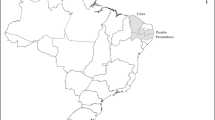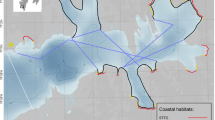Abstract
Recent findings reported a significant decrease in abundance of two seahorse species (Hippocampus guttulatus and H. hippocampus) in the Ria Formosa lagoon (South Portugal) and no direct causes have been, so far, clearly identified. This study aimed to describe fluctuations in the local seahorse populations through monthly surveys over a course of a year, in order to identify some of the potential drivers behind the seasonal fluctuations. A total of six sites were chosen based on their habitat characteristics. The highest H. guttulatus abundances were recorded at sites with higher holdfast availability and depth ranging from 3 to 6 m, while H. hippocampus were observed at highest numbers in sites with lower holdfast availability and patchy distribution. In most sites, seahorse density decreased during the summer months (from May to August) and increased from August to December. Holdfast use changed across the surveyed sites, according to the respective habitat characteristics. This study identified environmental variables that influenced the abundance of seahorse population, i.e., holdfast availability, depth and temperature in the Ria Formosa lagoon, underlining the importance of monitoring populations over a course of no less than a year in order to avoid bias due to seasonal fluctuations. Identifying critical habitats will provide valuable information for local authorities in order to implement protective measures towards seahorse conservation.






Similar content being viewed by others
References
Baum JK, Meeuwig JJ, Vincent ACJ (2003) Bycatch of lined seahorses (Hippocampus erectus) in a Gulf of Mexico shrimp trawl fishery. Fish Bull 101:721–731
Bell EM, Lockyear JF, McPherson JM, Marsden AD, Vincent ACJ (2003) First field studies of an endangered south African seahorse. Hippocampus capensis Environ Biol Fishes 67:35–46
Caldwell IR, Vincent ACJ (2012) Revisiting two sympatric European seahorse species: apparent decline in the absence of exploitation. Aquat Conserv Mar Freshwat Ecosyst 22:427–435
Caldwell IR, Vincent ACJ (2013) A sedentary fish on the move: effects of displacement on long-snouted seahorse (Hippocampus guttulatus Cuvier) movement and habitat use. Environ Biol Fish 96:67–75
Correia, M. (2015). Trends in seahorse abundance in the Ria Formosa, South Portugal: recent scenario and future prospects. p. 128 pp. Faro: Universidade do Algarve
Correia M, Caldwell I, Koldewey H, Andrade JP, Palma J (2015a) Seahorse (Hippocampinae) population fluctuations in the Ria Formosa lagoon, South Portugal. J Fish Biol 87:679–690
Correia M, Koldewey H, Andrade JP, Palma J (2015b) Effects of artificial holdfast units on seahorse density in the Ria Formosa lagoon, Portugal. J Exp Mar Biol Ecol 471:1–7
Correia M, Koldewey H, Andrade JP, Palma J (2016) A novel underwater visual census: seahorse population survey as a case study. Reg Stud Mar Sci 8:454–458
Cunha AH, Santos RP, Gaspar AP, Bairros MF (2005) Seagrass landscape-scale changes in response to disturbance created by the dynamics of barrier-islands: a case study from Ria Formosa (southern Portugal). Estuar Coast Shelf Sci 64:636–644
Cunha AH, Assis JF, Serrão EA (2013) Seagrasses in Portugal: a most endangered marine habitat. Aquat Bot 104:193–203
Cunha AH, Assis JF, Serrão EA (2014) Reprint of “Seagrasses in Portugal: a most endangered marine habitat”. Aquat Bot 115:3–13
Curtis JMR, Vincent ACJ (2005) Distribution of sympatric seahorse species along a gradient of habitat complexity in a seagrass-dominated community. Mar Ecol Prog Ser 291:81–91
Curtis JMR, Vincent ACJ (2006) Life history of an unusual marine fish: survival, growth and movement patterns of Hippocampus guttulatus Cuvier 1829. J Fish Biol 68:707–733
Curtis JMR, Ribeiro J, Erzini K, Vincent ACJ (2007) A conservation trade-off? Interspecific differences in seahorse responses to experimental changes in fishing effort. Aquat Conserv Mar Freshwat Ecosyst 17:468–484
Foster SJ, Vincent ACJ (2004) Life history and ecology of seahorses: implications for conservation and management. J Fish Biol 65:1–61
Freret-Meurer NV, Andreata JV (2008) Field studies of a Brazilian seahorse population, Hippocampus reidi Ginsburg, 1933. Braz Arch Biol Technol 51 (4):543–551
Gristina M, Cardone F, Carlucci R, Castellano L, Passarelli S, Corriero G (2015) Abundance, distribution and habitat preference of Hippocampus guttulatus and Hippocampus hippocampus in a semi-enclosed Central Mediterranean marine area. Mar Ecol 36:57–66
Guimarães MHME, Cunha AH, Nzinga RL, Marques JF (2012) The distribution of seagrass (Zostera noltii) in the Ria Formosa lagoon system and the implications of clam farming on its conservation. J Nat Conserv 20:30–40
Harasti D, Martin-Smith K, Gladstone W (2012) Population dynamics and life history of a geographically restricted seahorse, Hippocampus whitei. J Fish Biol 81:1297–1314
Harasti D, Martin-Smith K, Gladstone W (2014) Does a no-take marine protected area benefit seahorses? PLoS One 9:e105462
Hastie T, Tibshirani R (1990) Generalized additive models. Chapman and Hall, London
IUCN (2014). IUCN Red List of Threatened Species. Version 2014.2. www.iucnredlist.org
Koldewey HJ, Martin-Smith KM (2010) A global review of seahorse aquaculture. Aquaculture 302:131–152
Lourie SA, Foster SJ, Cooper EW, Vincent AC (2004) A guide to the identification of seahorses. Project seahorse and TRAFFIC North America. University of British Columbia and World Wildlife Fund, Washington, DC
Martins, J. T., Ferreira, Ó., Ciavola, P. & Dias, J. A. (1996). Monitoring of profile changes at Praia de Faro, Algarve: a tool to predict and solve problems. In Partnership in Coastal Zone Management. (Taussik, J. & Mitchell, J., eds.), pp. 615–622: Samara Publishing Limited, Cardigan
Martin-Smith KM, Vincent ACJ (2005) Seahorse declines in the Derwent estuary, Tasmania in the absence of fishing pressure. Biol Conserv 123:533–545
Martin-Smith KM, Vincent ACJ (2006) Exploitation and trade of Australian seahorses, pipehorses, sea dragons and pipefishes (family Syngnathidae). Oryx 40:141–151
Masonjones HD, Rose E, McRae LB, Dixson DL (2010) An examination of the population dynamics of syngnathid fishes within Tampa Bay, Florida. USA Current Zoology 56:118–133
Pacheco A, Ferreira Ó, Williams JJ, Garel E, Vila-Concejo A, Dias JA (2010) Hydrodynamics and equilibrium of a multiple-inlet system. Mar Geol 274:32–42
R Core Team (2016) R: A language and environment for statistical computing. R Foundation for Statistical Computing, Vienna. https://www.R-project.org/
Ribeiro J, Bentes L, Coelho R, Goncalves JMS, Lino PG, Monteiro P, Erzini K (2006) Seasonal, tidal and diurnal changes in fish assemblages in the Ria Formosa lagoon (Portugal). Estuarine Coastal and Shelf Science 67:461–474
Rosa IL, Oliveira TPR, Castro ALC, de Souza Moraes LE, Xavier JHA, Nottingham MC, Dias TLP, Bruto-Costa LV, Araújo ME, Birolo AB, Mai ACG, Monteiro-Neto C (2007) Population characteristics, space use and habitat associations of the seahorse Hippocampus reidi (Teleostei: Syngnathidae). Neotrop Ichthyol 5(3):405–414
Swartzman G, Huang C, Kaluzny S (1992) Spatial analysis of Bering sea groundfish survey data using generalized additive models. Can J Fish Aquat Sci 49(7):1366–1378
Teske PR, Lockyear JF, Hecht T, Kaiser H (2015) Does the endangered Knysna seahorse, Hippocampus capensis, have a preference for aquatic vegetation type, cover or height? Afr Zool 42(1):23–30
Vincent ACJ (1994) Operational sex-ratios in seahorses. Behaviour 128:153–167
Vincent ACJ (1995) A role for daily greetings in maintaining seahorse pair bonds. Anim Behav 49:258–260
Vincent, A. C. J. (1996). The international trade in seahorses. In TRAFFIC International, p. 163. Cambridge, UK
Wood S (2001) mgcv: GAMs and generalized ridge regression for R. R News 1:20–25
Wood SN (2006) Generalized additive models: an introduction with R. Chapman & Hall/CRC Press, Boca Raton
Wood SN, Augustin NH (2002) GAMs with integrated model selection using penalized regression splines and applications to environmental modelling. Ecol Model 157(2-3):157–177
Woodall LC, Koldewey HJ, Shaw PW (2011) Serial monogamy in the European long-snouted seahorse Hippocampus guttulatus. Conserv Genet 12:1645–1649
Woodall LC, Otero-Ferrer F, Correia M, Curtis JMR, Garrick-Maidment N, Shaw PW, Koldewey HJ (2018) A synthesis of European seahorse taxonomy, population structure, and habitat use as a basis for assessment, monitoring and conservation. Mar Biol 165:1–19
Acknowledgments
Miguel Correia was supported by a PhD grant (Fundação para a Ciência e Tecnologia - Portugal) (BD/41020/2007). The study was supported by the scientific projects INAQUA (Oceanario de Lisboa, National Geographic Channel) and HIPPOSAFE (Fundação para a Ciência e Tecnologia, ref. PTDC/MAR/122616/2010). Thanks are also due to Project Seahorse (http://seahorse.fisheries.ubc.ca/) for providing logistic support for underwater surveys and to all the volunteers that have participated in the data collection.
Author information
Authors and Affiliations
Corresponding author
Ethics declarations
Ethical compliance
All applicable international, national, and/or institutional guidelines for the care and use of animals were followed.
Conflict of interest
The authors declare that they have no conflict of interest.
Rights and permissions
About this article
Cite this article
Correia, M., Koldewey, H.J., Andrade, J.P. et al. Identifying key environmental variables of two seahorse species (Hippocampus guttulatus and Hippocampus hippocampus) in the Ria Formosa lagoon, South Portugal. Environ Biol Fish 101, 1357–1367 (2018). https://doi.org/10.1007/s10641-018-0782-7
Received:
Accepted:
Published:
Issue Date:
DOI: https://doi.org/10.1007/s10641-018-0782-7




